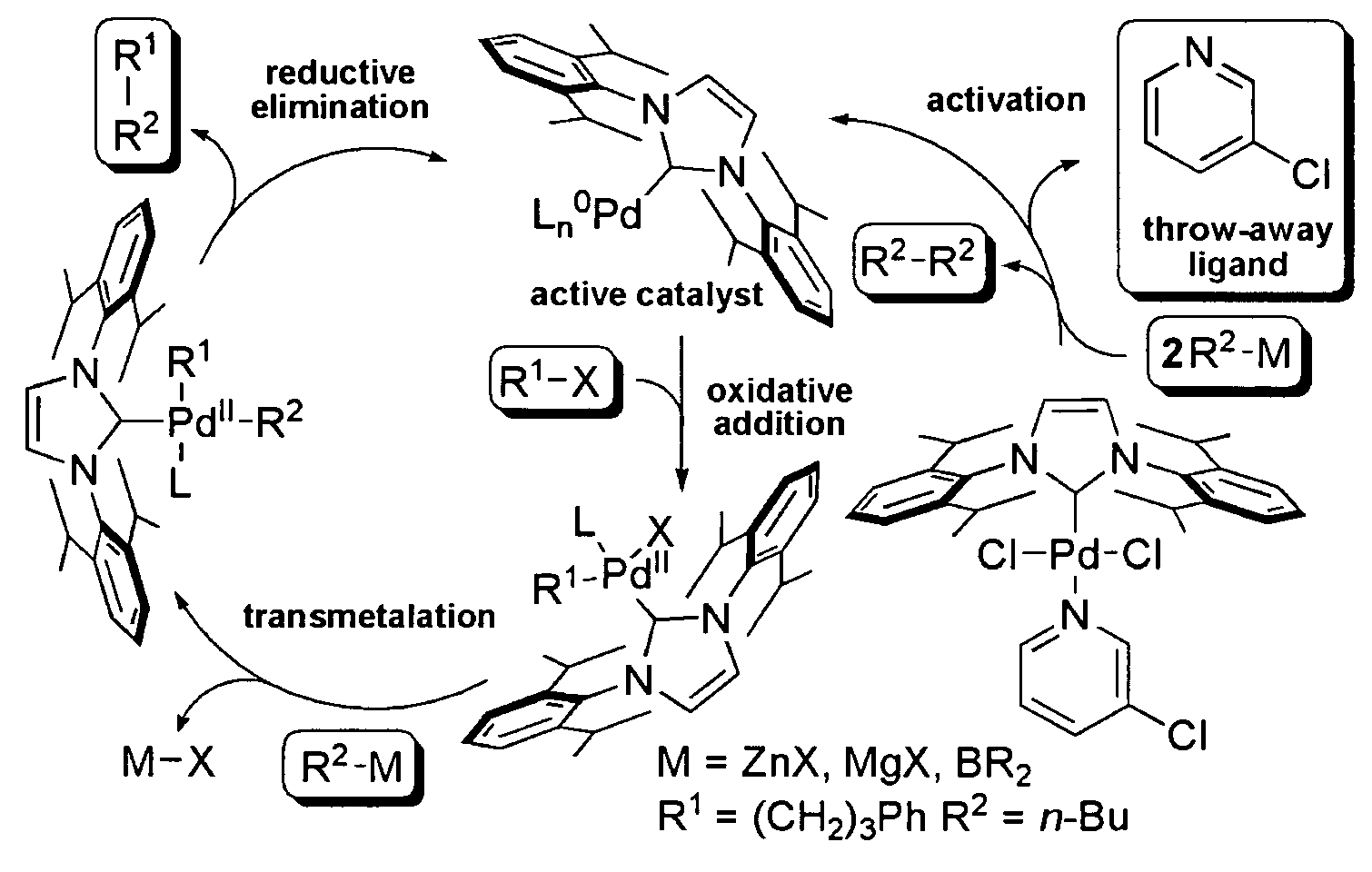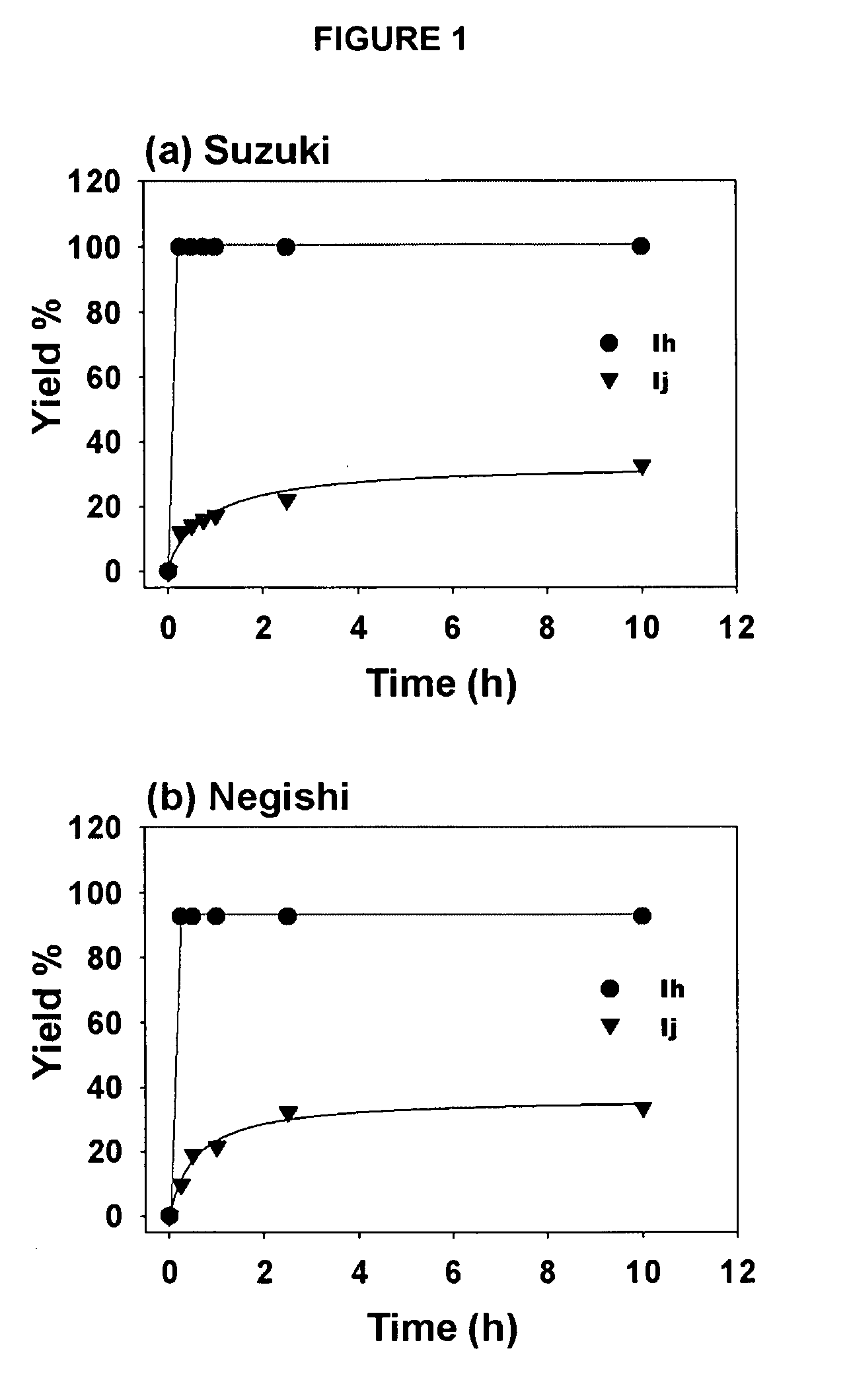Transition metal complexes of N-heterocyclic carbenes, method of preparation and use in transition metal catalyzed organic transformations
a transition metal and complex technology, applied in the field of chemical synthesis, can solve the problems of air sensitive phosphines, still under-used, and less successful development of nhc-based protocols
- Summary
- Abstract
- Description
- Claims
- Application Information
AI Technical Summary
Benefits of technology
Problems solved by technology
Method used
Image
Examples
experimental examples
Example 1
Synthesis of the NHC—PdCl2-3-chloropyridine Complexes
[0107]
(I) General Synthesis:
[0108]In air, a vial was charged with PdCl2 (177 mg, 1.0 mmol), NHC.HCl (1.1 mmol), K2CO3 (691 mg, 5.0 mmol) and a stir bar. 3-Chloropyridine (IVa, 4.0 mL) was added, the vial was capped with a Teflon®-line screw cap and heated with vigorous stirring for 16 hours at 80° C. After cooling to room temperature, the reaction mixture was diluted with CH2Cl2 and passed through a short pad of silica gel covered with a pad of Celite®, eluting with CH2Cl2 until the product was completely recovered. Most of the CH2Cl2 was removed (rotary evaporator) at room temperature, and the 3-chloropyridine was then vacuum-distilled (water aspirator vacuum) and saved for reuse. The pure complexes were isolated after titrating with pentane, decanting of the supernatant and drying in high vacuum.
(i) Complex Ih.
[0109]From IPr.HCl, IIa, (468 mg, 1.1 mmol), the complex Ih (677 mg, 97%) was obtained as a yellow solid, mp=24...
example 2
Catalytic Activity of the NHC—Pd Catalysts Ih, Ii and Ij in alkyl-alkyl Cross-coupling Reactions
[0122]
[0123]Complex Ih (Example 1, 1 mol %) was subjected to standard alkyl-alkyl Suzuki and Negishi cross-coupling reactions. Reaction conditions are provided in Table 1. The reactions were rapid (Suzuki 5 minutes, Negishi 30 minutes). Quantitative formation of the reaction product was observed at room temperature (Table 1).
example 3
Rate Studies with Complexes Ih and Ij in alkyl-alkyl Cross-couplings Shown in Example 2
[0124]The results of the rate studies with complexes Ih and Ij (see Example 1) in the alkyl-alkyl cross-couplings (a) Suzuki reaction, (b) Negishi reaction are shown in FIG. 1. The yields were determined by GC / MS against a calibrated internal standard (undecane). As seen in FIG. 1, the rate of the reaction with complex Ij was much slower than with complex Ih. While not wishing to be limited by theory, these results are suggestive that bulky NHC ligands lead to fast reductive elimination, which suppresses undesired side reactions or catalyst decomposition in a manner analogous with bulky phosphines. Since complexes Ih, Ij and Ii are air- and water tolerant and do not decompose upon standing, heating Ih at 100° C. in DMSO-d6 for 24 hours led to no visable decomposition (by 1H and 13C NMR spectroscopic analysis). Thus, it is unlikely that pyridine dissociation initiates catalyst activation considerin...
PUM
| Property | Measurement | Unit |
|---|---|---|
| temperature | aaaaa | aaaaa |
| temperature | aaaaa | aaaaa |
| temperature | aaaaa | aaaaa |
Abstract
Description
Claims
Application Information
 Login to View More
Login to View More - R&D
- Intellectual Property
- Life Sciences
- Materials
- Tech Scout
- Unparalleled Data Quality
- Higher Quality Content
- 60% Fewer Hallucinations
Browse by: Latest US Patents, China's latest patents, Technical Efficacy Thesaurus, Application Domain, Technology Topic, Popular Technical Reports.
© 2025 PatSnap. All rights reserved.Legal|Privacy policy|Modern Slavery Act Transparency Statement|Sitemap|About US| Contact US: help@patsnap.com



